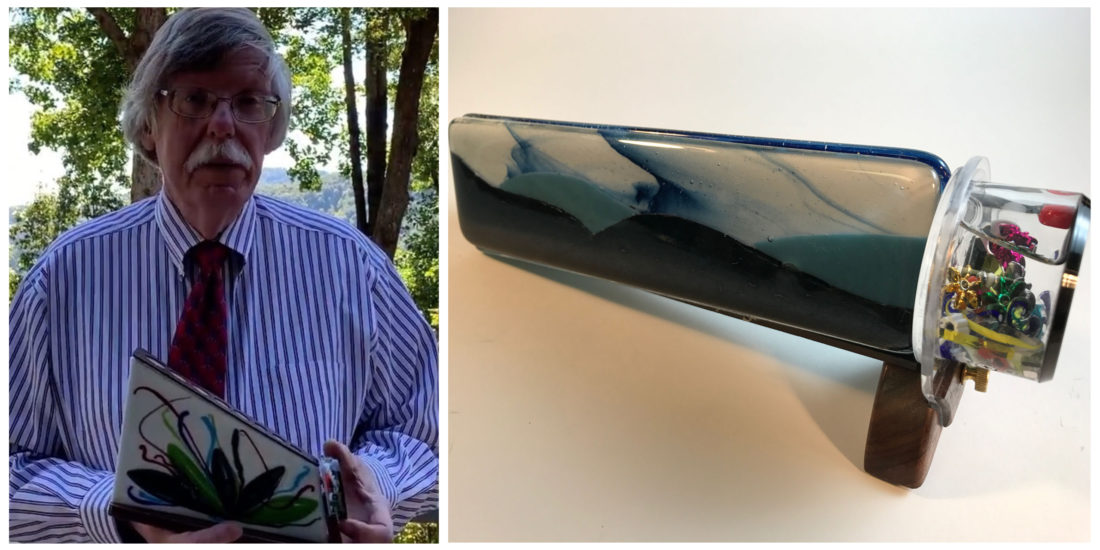
Probably few people have found artistic pursuits that so perfectly synthesize their strengths and interests as Marshall Fisher has with building kaleidoscopes.
A native of western Michigan, Fisher relocated to Black Mountain by way of Maryland in 2010 after a 30-year career as an engineer. But his passion for creating far precedes his professional days.
At 15, he began making mobiles and selling them at art shows. “It was pretty amateur stuff, but nevertheless,” Fisher says. “And I’ve always liked to work in wood. I’ve been a woodworker for as long as I can remember.”
Mirrors, lenses and colored objects
In the late 1980s, Marshall attended an exhibit of kaleidoscopes at the Mansion at Strathmore in Bethesda, Md., which he says was one of the world’s first such showcases. It was also the first time Fisher had seen the creations treated as art instead of cheap children’s toys. He recalls being “blown away” by the high optical standards, clear mirrors and sharply defined images. The pieces spoke to his prior craft work, and he felt called to see if he could make one.
Since his earliest efforts, Fisher notes, very little technical information has been available regarding how to build a kaleidoscope, though he has managed to track down a few helpful books.
In 1994, after several years of experimenting with various combinations of mirrors, lenses and colored objects, Fisher constructed a scope that he felt confident enough to enter in his first craft show in Rockville, Md. From there, he was hooked and feels that the overlaps between his engineering and maker sides have a lot to do with his passion for the craft.
“I like precision, I like clear and clean solutions, and I like solving problems,” he says. “Kaleidoscopes appeal to that, because there aren’t many parts to a kaleidoscope. In essence, there are really only three.”
Those components are the mirrors, the case and a moving object. Each kaleidoscope incorporates a prism or “tube” of mirrors, and the multiple reflections inside the prism produce symmetrical images. Fisher says infinite variations are possible in the mirror arrangement through the number of mirrors used and the angles at which they meet, the combination of which dictates the type of image produced.
“The mirror type and the accuracy with which the mirrors are cut and joined is very important to the quality of the image,” he explains. “A quality kaleidoscope will be made with front-surface mirrors, in which the silver coating is on the front instead of the back, eliminating errors that would result from the reflection passing through the glass.”
The color and texture of the image seen within the kaleidoscope is produced by a colorful, often transparent object that moves in some way at the end of the mirror prism. Fisher notes that the object can be a rotating wheel or wheels, a cylinder or a transparent cell filled with small colored pieces of glass, metal or even flowers. And in some instances, the cell is filled with a clear fluid that results in the sensation of the objects floating through the viewer’s field of vision as the cell rotates.
History and craft
Though the exterior case of a kaleidoscope is primarily protective of the interior mirror prism and in most cases purely decorative, Fisher strives to leave his creative mark on this element as well. In his Black Mountain home, he has separate studios for wood and glass and tries to incorporate both into the body.
In tandem with his enduring commitment to the craft, Fisher has learned much about the history of kaleidoscopes, beginning with their invention in 1816 at the hands of Scotsman David Brewster in England. The objects changed from items of scientific curiosity and status-symbol cornerstones of Victorian parlors to cheaply made children’s toys during the 20th century. But since the late ’80s, the designs have enjoyed a resurgence as works of art.
Aiding that return to glory is the Brewster Kaleidoscope Society, a group of roughly 150 people around the world — including Fisher — making high-quality instruments. The group meets annually each May to present new work and exchange ideas.
While Fisher stopped participating in craft shows in 2019, his creations may be viewed in person at Seven Sisters Gallery in Black Mountain and on the website for his business, Optical Wonders. Whether or not kaleidoscopes had become an integral part of his life, he’s confident that he would have spent his days making things but feels fortunate that he’s found his calling.
“Kaleidoscopes have proven to be a very fruitful and rewarding thing because there are so many skills required to make them all come together,” Fisher says. “I can work on wood, I can work on glass. It involves mathematics and manual skills of making small objects. It’s a never-ending source of challenge.”
To learn more, visit avl.mx/ag0.
This article is part of our feature, Creatives in the Crowd, which focuses on local artists — both established and new. The feature will spotlight unique stories and innovative artistic approaches within our creative community. Unlike much of our Arts & Culture reporting, these stories are not tied to upcoming events, exhibits or releases. The feature strives to represent a diverse range of voices, experiences and artistic mediums. If you’d like to nominate a community member for consideration, please reach out to ae@mountainx.com with the subject line “Creatives in the Crowd.”
"crowd" - Google News
October 01, 2021 at 12:00AM
https://ift.tt/3ojMuKs
Creatives in the Crowd: Marshall Fisher finds infinite possibilities with kaleidoscopes - Mountain Xpress
"crowd" - Google News
https://ift.tt/2YpUyMI
https://ift.tt/2KQD83I
Bagikan Berita Ini














0 Response to "Creatives in the Crowd: Marshall Fisher finds infinite possibilities with kaleidoscopes - Mountain Xpress"
Post a Comment